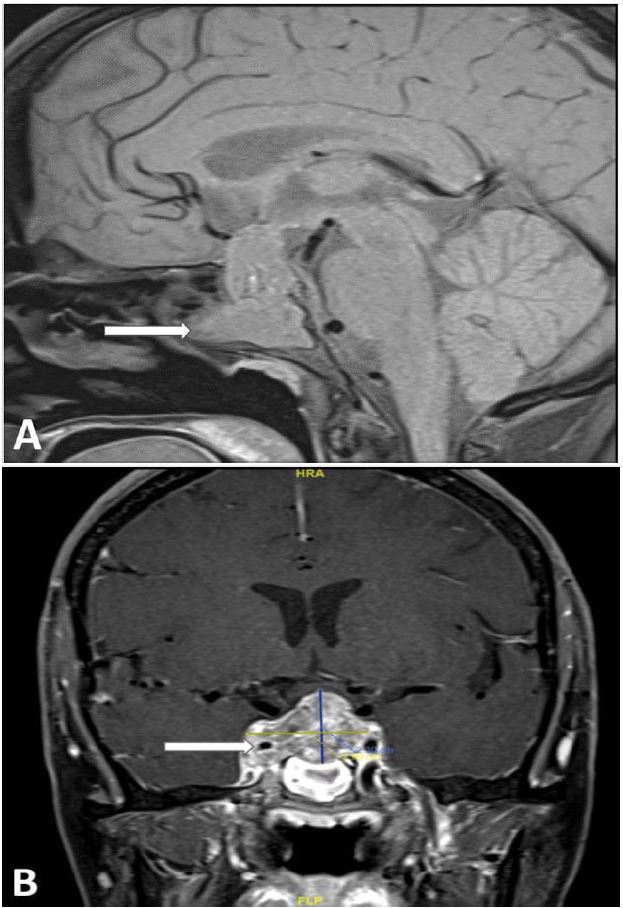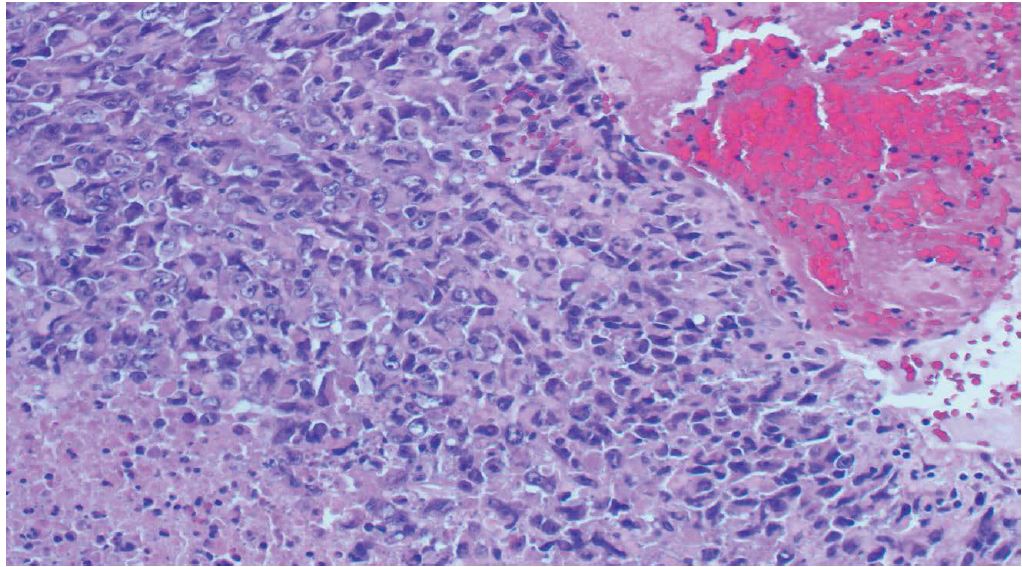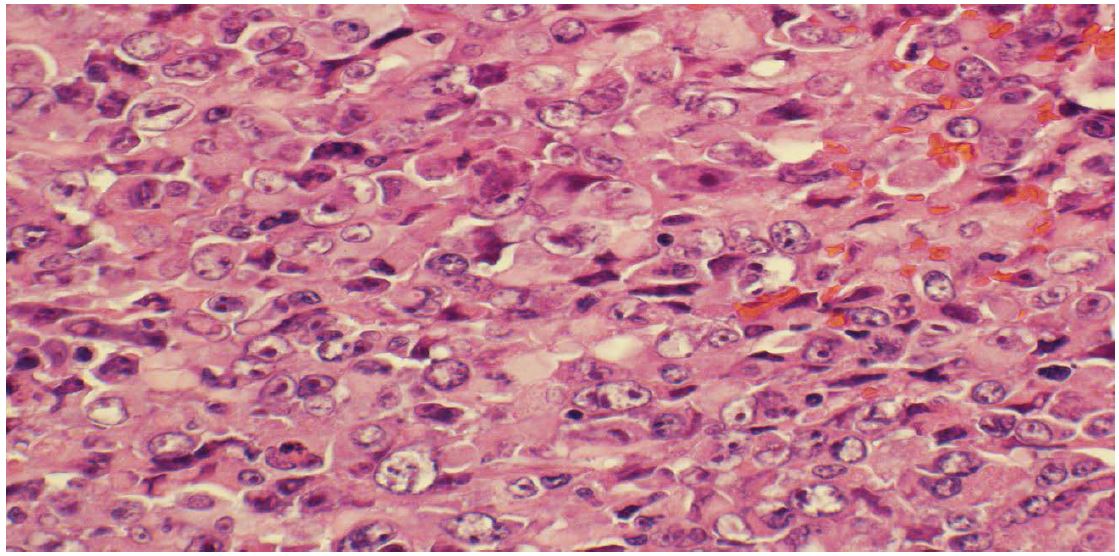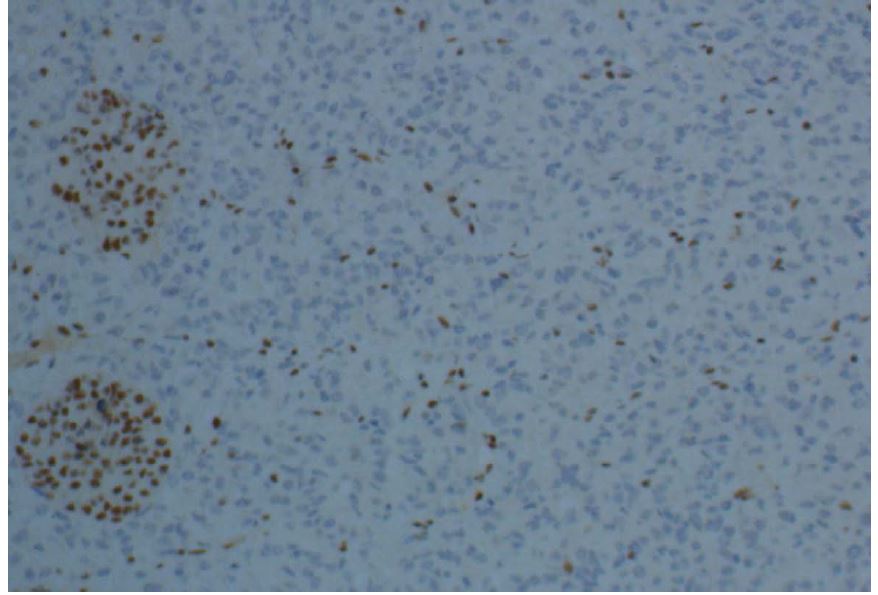Journal Name: Journal of Clinical Case Reports and Trials
Article Type: Case Report
Received date: 18 September 2019
Accepted date: 03 October 2019
Published date: 06 October 2019
Citation: Bokhari R, Bafaqeeh M, Al-Obaysi S, Al-Aman A, Alshakweer W (2019) Atypical Teratoid / Rhabdoid Tumor of the Sellar region: Case Report and Review of the Literature. J Clin Case Rep Trials. Vol: 2, Issu: 2 (01-05).
Copyright: © 2019 Bokhari R. This is an open-access article distributed under the terms of the Creative Commons Attribution License, which permits unrestricted use, distribution, and reproduction in any medium, provided the original author and source are credited.
Abstract
Atypical teratoid rhabdoid tumors (AT/RTs) are rare and aggressive pediatric malignant rhabdoid tumors (MRT) that occur within the brain. The majority of these tumors occur in the cerebellum. Only 45 cases of adults with AT/RT have been reported in the literature to date. We present a case of sellar and suprasellar AT/RT in a 40-year-old female patient with this rare entity. To our knowledge, this is the 14th case of an adult-onset AT/RT in the sellar and suprasellar region.
Keywords
Atypical teratoid / rhabdoid tumor, Sellar/suprasellar lesion, Surgery
Abstract
Atypical teratoid rhabdoid tumors (AT/RTs) are rare and aggressive pediatric malignant rhabdoid tumors (MRT) that occur within the brain. The majority of these tumors occur in the cerebellum. Only 45 cases of adults with AT/RT have been reported in the literature to date. We present a case of sellar and suprasellar AT/RT in a 40-year-old female patient with this rare entity. To our knowledge, this is the 14th case of an adult-onset AT/RT in the sellar and suprasellar region.
Keywords
Atypical teratoid / rhabdoid tumor, Sellar/suprasellar lesion, Surgery
Introduction
Atypical teratoid rhabdoid tumors (AT/RTs) are rare and aggressive pediatric malignant rhabdoid tumors (MRT) that occur within the brain [1]. It is initially reported in 1987 and subsequently, defined as a distinct CNS neoplasm in 1996. It is added to the World Health Organization (WHO) Brain Tumor Classification in 2007 (grade IV) [2,3]. Histologically, ATRT is known that they are composed of diffuse proliferation of atypical large cells showing eccentrically located nuclei and abundant eosinophilic cytoplasm (rhabdoid features) with prominent nucleoli [4]. AT/RTs are characterized by biallelic loss of SMARCB1. Here, we report a case of AT/ RT that originated in sellar and suprasellar region in a 40-year-old female patient with brief review of this aggressive tumor in adult population.
Case report
40-year-old right-handed female not known to have any medical illnesses, presented to the emergency department with a history of severe headache and decrease vision, which was more on the right eye. It was associated with nausea and vomiting for the last few days and photosensitivity as well. Clinical examination revealed decreased vision of the right eye and third nerve palsy of the same side. She denied any history of prolactinoma, constitutional symptoms and family history of pituitary tumors. MRl and CT scan showed sellar and suprasellar lesion that was invading the cavernous sinus bilaterally but more into the right side and protruding through the sella turcica. Preoperative magnetic resonance imaging (MRI) identified a large sellar enhancing lesion with cystic degeneration measuring 2.9 x 1.7 x 2.3 mm. (Figure 1).
Hormone profiles including cortisol, plasma adrenocorticotropic hormone (ACTH, thyroid hormones TSH and T4 follicle stimulating hormone (FSH), luteinizing hormone (LH) and Growth hormone, prolactin was normal.
Figure 1:(a) T1-weighted MRI Sagittal, images show large intrasellar mass (arrow), (b)T1-weighted MRI Coronal, images show large intrasellar mass encasing right internal carotid artery (arrow).
Figure 2:Tumor is composed of sheets of undifferentiated cells with large area of necrosis and hemorrhage (H&E stain, ×200 magnifications).
Classical trans-nasal endoscopic approach surgery was started by ENT surgeons, after exposing the base of sella the neurosurgeon took over, dissection of the tumor from the right side, posterior and anterior was done. The tumor was rubbery and fibrotic which was unusual to pituitary adenoma. Shifting to left side of the cavernous, the pituitary was lying over the medial wall of the cavernous sinus.
The histopathological study revealed a high-grade densely cellular neoplasm (Figure 2). Tumor cells were large-sized, polygonal in shape and arranged in sheets. The cytoplasm was eosinophilic with focal eccentric eosinophilic globular inclusions. The nuclei were ovalshaped and pleomorphic with prominent nucleoli (Figure 3). First differential diagnosis was pituitary adenoma as it is the most common tumor in the sellar region. Other differential diagnosis would include glioma and atypical teratoid rhoboid tumors. Negative staining for pituitary panel, chromogranin and synaptophysine excluded pituitary adenoma and other neuroendocrine tumors as well. Glial fibrillary acidic protein (GFAP) was negative excluding glial tumor. Immunohistochemical stain for INI-1 (BAF- 47) was negative in the tumor nuclei (Figure 4). The morphologic characteristics and immunoprofile were diagnostic of AT/RT.
Figure 3:Tumor is composed of Medium sized to large cells with prominent nucleoli and some with peripherally placed nuclei. (H&E stain, ×400 magnifications).
Figure 4:INI-1 (BAF-47) immunostaining shows loss of nuclear staining in the tumor nuclei and positive in the endothelial cells and residual intrapped pituitary tissue. (× 200 magnification).
Post-operative she developed diabetes insipidus (DI) which was treated by desmopressin. She was for follow up with endocrinologist, she had complete ptosis. She was referred to oncology team, started on chemo-radiation therapy. One month later the patient died due to respiratory failure secondary to acute respiratory distress syndrome in shock state and acute kidney injury.
Discussion
Atypical teratoid rhabdoid tumors (AT/RTs) are aggressive pediatric malignant brain tumors that accounts for approximately 1-2% of pediatric cancers of the CNS [5]. The majority of these tumors (approximately 60%) occurs in the posterior cranial fossa (particularly the cerebellum) [6]. Only 45 cases of adults with AT/RT have been reported in the literature to date [5]. Ostrom et al. reported that the most common location in adults is the cerebral hemisphere, followed by the sellar region [7]. In contrast, Vivien et al. found that the most common location was the sellar region (46%), followed by cerebral hemisphere (32%) [8]. Sellar AT/RTs were reported to be almost exclusively in females and not in the pediatric population [9,10]. Recently, it has been reported in the sellar region, with only 14 cases reported in the literature to date including our case (Table 1) [4,6,11-19]. All fourteen cases are female of age range between (20- 61) years old, and most of the cases presented with visual disturbance and oculo- palsies.
Radiological findings of sellar AT/RT are non-specific but are remarkably similar to pituitary adenoma; the lesions are isointense on T1-weighted imaging and enhance following gadolinium administration [12]. Histologically, AT/RT are composed of diffuse proliferation of atypical large cells showing eccentrically located nuclei and abundant eosinophilic cytoplasm (rhabdoid features) with
Table 1:Summary of previously described of sellar AT/RTs and the present case
| Year | Age/Sex | Presentation | Treatment | Outcome | Reference | |
|---|---|---|---|---|---|---|
| 1 | 2000 | 32/F | Visual disturbance | Resection, Radiation, and Chemotherapy | 28 months (dead) | [12] |
| 2 | 2005 | 20/F | Visual disturbance | Resection, Radiation, and Chemotherapy | 28 months (survived) | [13] |
| 3 | 2005 | 31/F | Not mentioned | Resection, and Radiation. | 9 months (dead) | [13] |
| 4 | 2008 | 56/F | Diplopia | Resection, and Radiation. | 23 months (dead) | [14] |
| 5 | 2010 | 46/F | Headache | Not mentioned | Not mentioned | [15] |
| 6 | 2011 | 61/F | Diplopia | Resection | 3 months (dead) | [16] |
| 7 | 2011 | 57/F | Diplopia | Resection, Radiation, and Chemotherapy | 6 months (survived) | [16] |
| 8 | 2013 | 60/F | Headache and diplopia | Resection, radiation, and chemotherapy | 30 months (dead) | [17] |
| 9 | 2013 | 43/ F | Headache and diplopia | Resection and radiation | 2 weeks (survived) | [18] |
| 10 | 2014 | 44 /F | Visual disturbance | Resection, radiation, and chemotherapy | 17 months (dead) | [19] |
| 11 | 2014 | 42/F | Visual disturbance | Resection, radiation, and chemotherapy | 27 months (survived) | [5] |
| 12 | 2015 | 36 /F | Headache and blurred vision | Resection, radiation, and chemotherapy | 29 months (dead) | [20] |
| 13 | 2017 | 35/ F | Headache, diplopia, and amenorrhea | Resection, radiation, and chemotherapy | 37 months (survived) | [7] |
| 14 | Present case | 40/F | Headache, right oculomotor palsy with decrease vision | Resection, radiation, chemotherapy | 2 months |
prominent nucleoli [4]. SMARCB1/INI1 is one of the core subunit proteins of the ATP‐dependent SWI/SNF chromatin remodeling complex, and is identified as a potent and bona fide tumor suppressor [20]. Interactions have been demonstrated between SMARCB1/INI1 and key proteins in various pathways related to tumor proliferation and progression: the p16‐RB pathway, WNT signaling pathway, sonic hedgehog signaling pathway and Polycomb pathway [20]. The molecular changes in AT\RTs include a mutation in one allele with a second allele loss due to monosomy 22, deletion of 22q11.2, or an acquired copy number neutral loss heterozygosity [21, 22]. Sellar AT/RTs also have a higher prevalence of biallelic INI1 alterations compared to AT/RTs in other locations [10]. Loss of expression of INI1 as detected by immunohistochemical staining correlates with deletion and mutations of the INI1 gene [23]. The differential diagnosis of sellar mass includes pituitary adenomas (85%), followed by craniopharyngioma (3%), rathke cleft cyst (2%), meningioma (1%) [24]. Pituitary adenoma shows uniform nuclear morphology with moderately abundant cytoplasm, and the neoplastic cells are highlighted by synaptophysin and chromogranin. Craniopharyngioma have a distinct morphology that the neoplastic cells are forming nodules or trabeculae of squamous epithelium, with peripheral nuclear palisading that surrounds looser plumper cells called “stellate reticulum”. In addition, nodules of anucleated squamous (“ghost” cells) and “wet” keratin are usually present. Rathke cleft cyst is a cyst lined by columnar ciliated epithelium with goblet cells. Meningioma usually have syncytial cells that have round uniform nuclei with intranuclear pseudo inclusions.
The prognosis of AT/RT is poor both in adults and in the pediatric population, Vivien et al, report the average survival rate of adult AT/RT is 20 months [8]. This is comparable to the reported median survival of 13.5 to 16.8 months in the pediatric population [10,25]. Long-term survival is possible in adult AT/RT cases after a combined approach including surgery, adjuvant radiotherapy, and chemotherapy [26, 27] (Table 1).
Conclusion
AT/RT is not limited to pediatric age group, it should be considered in the differential diagnosis of malignant sellar lesion in adult patients.
Funding
This study is not funded.
Conflicts of Interest
The authors declare that they have no conflicts of interest.
Ethical Approval
This article does not contain any studies with human participants performed by any of the authors.
Swethajit Biswas, Madeleine Wood, Abhijit Joshi, Nick Bown, Lisa Strain, et al. (2015) Exome Sequencing of an Adult Pituitary Atypical Teratoid Rhabdoid Tumor. Front Oncol 5: 236. [ Ref ]
Rorke L, Packer R, Biegel J (1996) Central nervous system atypical teratoid/rhabdoid tumors of infancy and childhood: definition of an entity. J Neurosurg 85: 56-65. [ Ref ]
Kleihues, Paul (2000) World Health Organization. Pathology and Genetics of Tumours of the Nervous System. Lyon, Iarc. [ Ref ]
Park HG, Yoon JH, Kim SH, Cho KH, Park HJ, et al (2014) Adult-onset sellar and suprasellar atypical teratoid rhabdoid tumor treated with a multimodal approach: a case report. Brain Tumor Res Treat 2: 108-113. [ Ref ]
Souki C, Abdel-Rhaman M, Qasem A, Al-Hussaini M (2014) Atypical teratoid rhabdoid tumor in adulthood. Clin Neuropathol 33: 245-250. [ Ref ]
Almalki MH, Alrogi A, Al-Rabie A, Al-Dandan S, Altwairgi A, et al. (2017) Atypical teratoid/rhabdoid tumor of the sellar region in an adult with long survival: case report and review of the literature. J Clin Med Res 9: 216-220. [ Ref ]
Ostrom QT, Chen Y, M de Blank P, Ondracek A, Farah P (2014) The descriptive epidemiology of atypical teratoid/rhabdoid tumors in the United States, 2001-2010. Neuro Oncol 16:1392-1399. [ Ref ]
Vivien Chan, Alessandro Marro, J Max Findlay, Laura M Schmitt, Sumit Das (2018). A Systematic Review of Atypical Teratoid Rhabdoid Tumor in Adults. Front Oncol 8: 567. [ Ref ]
Nakata S, Nobusawa S, Hirose T, Ito S, Inoshita N, et al. (2017) Sellar atypical teratoid/rhabdoid tumor (AT/RT). The American journal of surgical pathology 41: 932-940. [ Ref ]
Nishikawa A, Ogiwara T, Nagm A, Sano K, Okada M, et al. (2018) Atypical teratoid/rhabdoid tumor of the sellar region in adult women: Is it a sexrelated disease?. J Clin Neurosci 49: 16-21 [ Ref ]
Kuge A1, Kayama T, Tsuchiya D, Kawakami K, Saito S (2000) Suprasellar primary malignant rhabdoid tumor in an adult: a case report. No Shinkei Geka. 28: 351-358. [ Ref ]
Raisanen J, Biegel JA, Hatanpaa KJ, Judkins A, White CL, Perry A. (2005) Chromosome 22q deletions in atypical teratoid/rhabdoid tumors in adults. Brain Pathology. Brain Pathol 15: 23-28. [ Ref ]
Arita K1, Sugiyama K, Sano T, Oka H (2008) Atypical teratoid/rhabdoid tumour in sella turcica in an adult. Acta Neurochir (Wien)150: 491-495. [ Ref ]
Las Heras F, Pritzker KP (2010) Adult variant of atypical teratoid/ rhabdoid tumor: immunohistochemical and ultrastructural confirmation of a rare tumor in the sella tursica. Pathology-Research and Practice 206: 788-791. [ Ref ]
Schneiderhan TM, Beseoglu K, Bergmann M, Neubauer U, Macht S, et al. (2011) Sellar atypical teratoid/rhabdoid tumours in adults. Neuropathology and applied neurobiology 37: 326-329. [ Ref ]
Costanzo Moretti, Domenico Lupoi, Francesca Spasaro, Laura Chioma, Paola Di Giacinto, et al. (2013) Sella turcica atypical teratoid/rhabdoid tumor complicated with lung metastasis in an adult female. Clin Med Insights Case Rep 6: 177-182. [ Ref ]
Chou S Q H, Lo S S M, Wong H N, Lau P, Chan C, et al. (2013) Atypical teratoid/rhabdoid tumour in the sella turcica of a female adult. Hong Kong J Radiol 16: 65-68. [ Ref ]
Shitara S, Akiyama Y (2014) Atypical teratoid/rhabdoid tumor in sellar turcica in an adult: a case report and review of the literature. Surg Neurol Int 23: 75. [ Ref ]
Lev I, Fan X, Yu R, (2015) Sellar atypical teratoid/rhabdoid tumor: any preoperative diagnostic clues?. AACE Clinical Case Reports 1: e2-e7. [ Ref ]
Kohashi K, Oda Y, (2017) Oncogenic roles of SMARCB 1/INI 1 and its deficient tumors. Cancer science 108:547-552. [ Ref ]
Biegel JA (2006) Molecular genetics of atypical teratoid/rhabdoid tumors. Neurosurgical focus 20: 1-7. [ Ref ]
Geller J I, Roth JJ, Biegel J A (2015) Biology and treatment of rhabdoid tumor. Crit Rev Oncog 20: 199-216. [ Ref ]
Judkins AR (2007) Immunohistochemistry of INI1 expression: a new tool for old challenges in CNS and soft tissue pathology. Adv Anat Pathol14: 335-339. [ Ref ]
Goldblum JR, et al (2017) Rosai and Ackermans Surgical Pathology E-Book, Elsevier. [ Ref ]
Lafay-Cousin L, Hawkins C, Carret AS, Johnston D, Zelcer S, at al. (2012) Central nervous system atypical teratoid rhabdoid tumours: the Canadian Paediatric Brain Tumour Consortium experience. European journal of cancer 48: 353-359. [ Ref ]
Parwani AV, Stelow EB, Pambuccian SE, Burger PC, Ali SZ (2005) Atypical teratoid/rhabdoid tumor of the brain: cytopathologic characteristics and differential diagnosis. Cancer Cytopathology: Interdisciplinary International Cancer 105: 65-70 [ Ref ]
Makuria AT, Rushing EJ, McGrail KM, Hartmann DP, Azumi N (2008) Atypical teratoid rhabdoid tumor (AT/RT) in adults: review of four cases. J Neurooncol 88: 321-330. [ Ref ]






